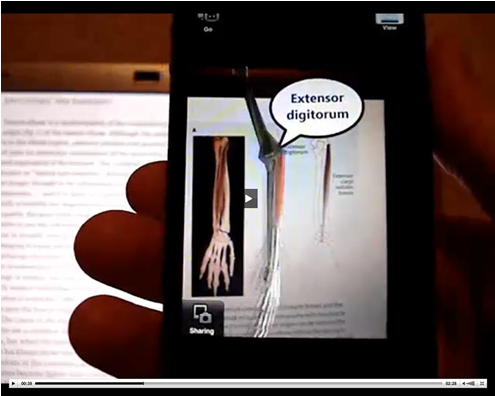Will Augmented Reality save print media?
28 Oct, 11 | by BMJ
There’s a notable scene in the film Minority Report, where a man reads a newspaper that updates in real time with breaking news. Whilst we are not quite at that stage yet, Augmented Reality (AR) is making use of computer visions algorithms in order to superimpose virtual information (2D or 3D, textual or pictorial) onto real world scenes in real time.
The last few months have seen a rush of activity around a related AR field – well, something that sits between augmented reality and image recognition – that focuses less on the world around you, and more on printed materials: newspapers, magazines, posters and packaging.
Some are heralding this development as the answer to dwindling print sales and AR has been highlighted as one of the important trends to watch in the near 2-3 years horizon (see 2011 Horizon Report). The crux of this vision is that smartphones now allow publishers to build this type of interactive experience right into their existing print content. No special markers, no desktop computer, no webcams: all a user needs to interact with augmented magazines, newspapers or milk cartons is a smartphone.
What’s on offer?
Blippar is the augmented reality app that created the first fully AR newspaper in Ireland. After the success of that campaign, they decided to aim higher and create the UK’s first AR print and image campaign. As part of the ‘Big Price Drop’ campaign run by UK superstore Tesco, Blippar ran a nationwide campaign where UK smartphone users could access these AR adverts and get further information about Tesco’s campaign. By using the Blippar app on their smartphone and scanning an advert either in a newspaper or outdoors, users were able to access information about store location and download new daily recipe ideas (see video below).
Layar is one of the veterans of mobile augmented reality, specialising in the ‘world around you strain’ of AR. In early August, though, it unveiled an extension to its technology called Layar Vision, focused on bringing AR to traditional printed media. Similar to Blippar, point your phone at a newspaper ad or poster and get audio, video, 3D objects and other data.
AXA released the first i-Ad, which integrates newspaper advertising with an iPhone. The video below explains the process in more detail, but the gist is that you come upon an engaging picture in print and are asked to place your iPhone on a blank space on the page which brings the story to life, and keeps eyeballs on the i-Ad for a full minute.
How engaging is this technology?
The May 2011 issue of CAR magazine featured AR print advertising in the form of a double-page spread advertising a Mercedes CL63 AMG. A picture of the interior of the car was shown with instructions on how to access the online content via smartphone, printed in the rear-view mirror.
Acentric conducted an ad test with 79 members of the Acentric online panel and found that the advert got an above average ‘attention’ score of 66.28, with males paying more attention than females. One of the nagging doubts about the likely effectiveness of AR print adverts is the additional effort required to fully appreciate such advertising. Approximately 63% appear to have played the video, which is fairly impressive. However, it should be borne in mind that in the real world this is likely to be lower as not everyone will have access to a smartphone and there is also little doubt that the novelty value of such adverts will begin to wear off.
Just for advertising?
The examples of AR included here have focused solely on print advertising but is there any reason why we couldn’t use the same technology to make print journal content more interactive? Perhaps by linking to related videos, podcasts or manipulable 3D images? Would you find this useful? Any feedback is most welcome.
